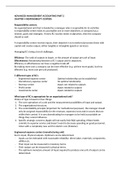Summary
Summary Major
- Course
- Institution
- Book
Extensive summary covering chapter 4 - 11 from the book Management Controls Systems (Second Edition). The book is used for the course Advanced Management Accounting at Erasmus University Rotterdam (EUR, Erasmus School of Economics), as part of the Major Financial Accounting. I achieved a 9.6/...
[Show more]



